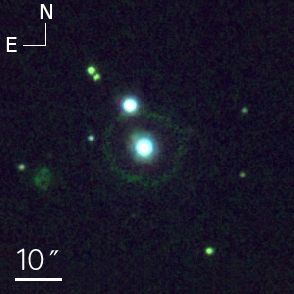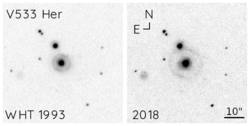Astronomy:V533 Herculis
 RGB composite color image of the faint shell surrounding V533 Herculis, made from three narrow band images: Blue = 4800Å, green = Hα at 6563 Å and red = [NII] at 6583 Å. From Santamaria et al. 2020[1] | |
| Observation data Equinox J2000.0]] (ICRS) | |
|---|---|
| Constellation | Hecules |
| Right ascension | 18h 14m 20.485s[2] |
| Declination | +41° 51′ 22.07″[2] |
| Apparent magnitude (V) | 3.0 - 15.0[3] |
| Astrometry | |
| Distance | 1202+52 −41[3] pc |
| Characteristics | |
| Variable type | Classical Nova |
| Other designations | |
V533 Her, Nova Her 1963, AAVSO 1811+41 | |
| Database references | |
| SIMBAD | data |
V533 Herculis was a nova visible to the naked eye, which occurred in 1963 in the constellation of Hercules.[4]
The nova was discovered by the Swedish amateur astronomer Elis Dahlgren on 6 February 1963, and independently by an American amateur, Leslie Peltier, on 7 February 1963.[5][6] Both reported it to be a 4th magnitude star.[7] Subsequent examination of pre-discovery images, taken by the Baker-Nunn satellite tracking group at the Tokyo Observatory, showed that the star had begun its nova event as early as 18:36 UT on 26 January 1963, when it had an magnitude of 8. It had attained its peak brightness, magnitude 3, by 17:38 UT on 30 January 1968.[6]
All novae are binary stars, with a "donor" star transferring matter to a white dwarf. In the case of V533 Herculis, the pair's orbital period is 3.43 hours.[8] Thorstensen and Taylor analysed spectra of the star in its quiescent state, and concluded that it is a non-eclipsing SW Sextantis variable, implying that the donor star is a red dwarf.[9] Knigge derived a mass of 0.225 M⊙, and a radius of 0.333 R⊙, for the donor star.[10]

Images of V533 Herculis taken with the Hubble Space Telescope show a faint, approximately circular shell (nebula) with a diameter of 10±1.4 arc seconds, surrounding the star. The shell is expanding at 850±150 km/sec.[11] Santamaria et al. obtained similar results by comparing images of the shell taken in 1993 and 2018. They found that by 2018 the slightly elliptical shell had major and minor axis of 16.8×15.2 arc seconds, and it was expanding at a rate of 0.152×0.139 arc seconds per year, implying a physical expansion rate of 850×770 km/sec.[1]
References
- ↑ 1.0 1.1 1.2 Santamaria, E.; Guerrero, M.A.; Ramos-Larios, G.; Toala, J.A.; Sabin, L.; Rubio, G.; Quino-Mendoza, J.A. (March 2020). "Angular Expansion of Nova Shells". The Astrophysical Journal 892 (1): 60. doi:10.3847/1538-4357/ab76c5. Bibcode: 2020ApJ...892...60S.
- ↑ 2.0 2.1 "V533 Her". SIMBAD. Centre de données astronomiques de Strasbourg. http://simbad.u-strasbg.fr/simbad/sim-basic?Ident=V533+Her.
- ↑ 3.0 3.1 Schaefer, Bradley E. (December 2018). "The distances to Novae as seen by Gaia". Monthly Notices of the Royal Astronomical Society 481 (3): 3033–3051. doi:10.1093/mnras/sty2388. Bibcode: 2018MNRAS.481.3033S.
- ↑ Sion, Edward M. et al. (2017). "Far Ultraviolet Spectroscopy of Old Novae. II. RR Pic, V533 Her, and DI Lac". The Astronomical Journal 153 (3): 109. doi:10.3847/1538-3881/153/3/109. PMID 29456254. Bibcode: 2017AJ....153..109S.
- ↑ Warner, B. (February 2006). "Where have all the novae gone?". Astronomy & Geophysics 47 (1): 29–32. doi:10.1111/j.1468-4004.2006.47129.x. Bibcode: 2006A&G....47a..29W.
- ↑ 6.0 6.1 Haddock, F.T.; Howard, W.E. III; Malville, J.M.; Selling, T.V. (October 1963). "An Upper Limit to the 8000 Mc/S Flux Density of Nova Herculis 1963". Publications of the Astronomical Society of the Pacific 75 (446): 456. doi:10.1086/128005. Bibcode: 1963PASP...75..456H.
- ↑ Mayall, Margaret W. (December 1963). "Variable Star Notes". Journal of the Royal Astronomical Society of Canada 57: 279. Bibcode: 1963JRASC..57..279M.
- ↑ McQuillin, Rachael; Evans, A.; Wilson, D.; Maxted, P.F.L.; Pollacco, D.; West, R.G.; Hounsell, R.A.; Bode, M.F. (January 2011). "Novae in the SuperWASP data base". Monthly Notices of the Royal Astronomical Society 419 (1): 330–335. doi:10.1111/j.1365-2966.2011.19695.x.
- ↑ Thorstensen, John R.; Taylor, Cynthia J. (March 2000). "Spectroscopy and orbital periods of the old novae V533 Herculis, V446 Herculis and X Serpentis". Monthly Notices of the Royal Astronomical Society 312 (3): 629–637. doi:10.1046/j.1365-8711.2000.03230.x. Bibcode: 2000MNRAS.312..629T.
- ↑ Knigge, Christian (31 October 2006). "The donor stars of cataclysmic variables". Monthly Notices of the Royal Astronomical Society 373 (2): 484–502. doi:10.1111/j.1365-2966.2006.11096.x. Bibcode: 2006MNRAS.373..484K.
- ↑ Gill, C.D.; O'Brien, T.J. (May 2000). "Hubble Space Telescope imaging and ground-based spectroscopy of old nova shells - I. FH Ser, V533 Her, BT Mon, DK Lac and V476 Cyg". Monthly Notices of the Royal Astronomical Society 314 (1): 175–182. doi:10.1046/j.1365-8711.2000.03342.x. Bibcode: 2000MNRAS.314..175G.
External links
 |



